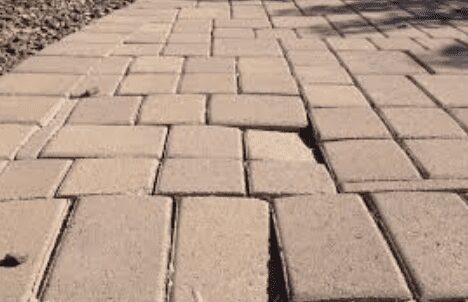6 Common Problems with Interlocking Pavers (and how to fix them)

Interlocking pavers provide a beautiful and durable solution for outdoor surfaces. However, like any construction project, they can encounter challenges. In this guide, we explore common issues with interlocking pavers and offer practical solutions to ensure your project lasts.
Problem 1: Uneven Height
Problem: Uneven pavers often result from insufficient depth or unevenness in the base. Clay soils, which retain more water, can cause pavers to push upwards during freezing periods.
Solution: Unfortunately, there’s no easy fix. You’ll need to start over by removing the stone dust and using processed gravel. Avoid cutting corners from the beginning to prevent this issue.
Problem 2: Disappearing Fixed Edges
Problem: Gravel and sand can wash out from under the pavers.
Solution: Use filter fabric beneath the base and extend it up the sides of the excavation. To fix affected areas, patch with filter fabric, add new base material, and reinstall the pavers.

Problem 3: Border Falling
Problem: Borders may fall if no edge restraint is installed.
Solution: Reinforce borders with concrete or metal edging, ensuring proper anchoring. Pull up the pavers, add more base and sand, and install an edge restraint.Water Puddling
Problem: Improper drainage can cause water to puddle on pavers, leading to safety hazards.
Solution: Grade the base to promote drainage, incorporating a slight slope. Consider installing permeable pavers or adding a drainage layer beneath the surface.
Problem 4: Area Settled
Problem: Settlement often occurs due to a lack of compaction.
Solution: Lift and re-level settled areas, adding or compacting base material as needed. Pay attention to areas prone to settlement, like those around tree roots.
Problem 5: Stains and Efflorescence
Problem: Stains from oil or organic materials and efflorescence can mar pavers’ appearance.
Solution: Clean stains promptly with recommended solutions. For efflorescence, use mechanical cleaning methods or specialized cleaners. Applying a quality sealant can prevent future issues.ance your outdoor space for years to come.
Problem 6: Stains and Efflorescence
Problem: Stains from oil or organic materials and efflorescence can mar pavers’ appearance.
Solution: Clean stains promptly with recommended solutions. For efflorescence, use mechanical cleaning methods or specialized cleaners. Applying a quality sealant can prevent future issues.
By addressing these common problems proactively, you can ensure the longevity and beauty of your interlocking paver installation. Prioritize proper preparation, regular maintenance, and prompt attention to deterioration signs. With care, your paver project will enhance your outdoor space for years to come.

